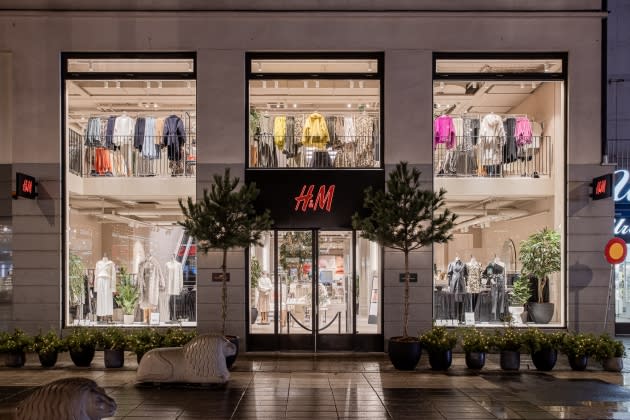H&M Announces Stock Buyback Program Amid Soaring H1 Sales

PARIS — The fast-fashion juggernaut rolls on.
Swedish retailer H&M Group, which operates Cos, Monki, & Other Stories, Arket and Weekday in addition to its core banner, announced a strong first half with a 20 percent jump in sales.
More from WWD
During a conference call with chief executive officer Helena Helmersson and head of investor relations Nils Vinge, the group credited the strong growth figures to full-price sales and lower markdowns, however they revealed plans to gradually increase prices to offset inflationary worries.
The group also detailed plans to open new stores in several developing markets, as well as a stock buyback plan to reduce capital.
Helmersson said that while the shift to e-commerce and online sales continues, the company “has seen fantastic recovery in physical stores.” She credited the boost to a lifting of COVID-19 restrictions around the world and shopping as a social activity.
However, the company cautioned about slowing sales in the current quarter as inflation worries abound. “There are different forces right now,” she said of the customer mood to go out and spend while facing the cost of living crunch.
The company intends to sequentially raise prices to offset their rising costs, however, Helmersson and Vinge could not be pinned down on the range of increases. They stated that it is a dynamic formula depending on “customer sentiment per market,” indicating that increases will be higher in more mature markets.
Helmersson framed any recession fears as a premise for growth, as customers are squeezed by other factors. “It’s very clear that there is a demand for affordable and sustainable fashion, so we actually think that we can strengthen our position further,” she said.
Vinge indicated that supply chain issues caused by the COVID-19 crisis are beginning to ease, and raw material prices are stabilizing. He specifically cited cotton and said inflation is “not worsening” on the commodity side, but rather on the transport and logistics side.
To ease their supply chain woes, the company is adjusting its purchasing patterns. “Throughout the autumn we will start to adjust them to better tailor to the new situation and continue to have the high precision that we offer. Slowly but surely we are seeing some positive signals of the disruptions and disturbances are easing,” Vinge said.
Following the Russian invasion of Ukraine, H&M closed its stores in both countries. The glut of merchandise already produced and intended for Russia is being diverted to other markets, mostly throughout Europe.
In China, where the company quietly closed its Shanghai flagship, H&M “is in a complex situation and not obviously on the level that we would have wished for,” Helmersson said. It is working on adjusting its mix of physical outlets and online sales.
That plays into what the company calls its “optimization strategy,” framed as part of a balancing act, with the group adjusting its locations.
It plans to open 94 new stores in growth markets, and close 272 stores in established markets, marking a net decrease of 178 stores.
The group is ramping up H&M sales in Latin America, with more store openings and an increased push for online sales. It will launch physical stores of its H&M flagship banner in six new markets this year, including Ecuador, Kosovo and North Macedonia as wholly owned stores, and in Costa Rica and Guatemala under franchise agreements. The group opened in Cambodia in March.
The majority of H&M closures will be in Europe, Helmersson said. However the group will open stores from its other brands, including Arket in France and & Other Stories in Singapore, as part of its push for global growth. The group has integrated their other brands into a single sales site as an experiment with positive results, and will continue to explore brand integration. It does not breakdown sales results by brand.
On the sustainability front, Helmersson responded to the news revealed June 13 that the company will be shuttering its Treadler sustainable supply chain business-to-business platform. She said the service was “not able to grow as fast as we would have wanted, meaning that right now it doesn’t seem that the market is there to the extent that we thought when it comes to sustainability.” She said the company will focus on other initiatives, and repeatedly reiterated the company is “affordable and sustainable.”
However it comes on the heels of a report that the group removed all of its self-assessed “environmental scorecards” from its website Wednesday, after data had been shown to be misleading or inaccurate.
H&M announced it would “pause” using the labels such as the Higg Index, after the Norwegian Consumer Authority found it was misleading consumers.
In response, Helmersson said the company is “following that development to see how to proceed.”
In half-yearly numbers, the group said net sales jumped 20 percent for the six months ending May 31 to 103.6 billion Swedish kronor, or $10.2 billion at current exchange. That amounts to a 15 percent increase in local currencies.
It reported a 5.3 increase in operating profit of 5.4 billion Swedish kronor, or $529.8 million. Gross profit totaled 54.1 billion Swedish kronor, or $5.3 billion. The group credited well-received collections for a boost in full-price sales and fewer markdowns.
Net cash increased to 16.31 billion Swedish kronor, or $1.6 billion. Some of that cash will be used to launch a stock buy-back program of 3 billion Swedish kronor, or $294.6 million. The group will launch the process on June 29 for five months in order to reduce capital.
Sign up for WWD's Newsletter. For the latest news, follow us on Twitter, Facebook, and Instagram.
